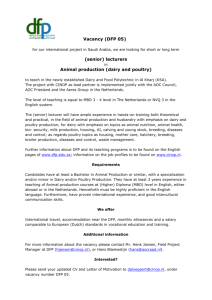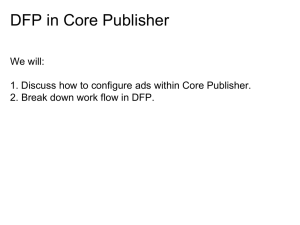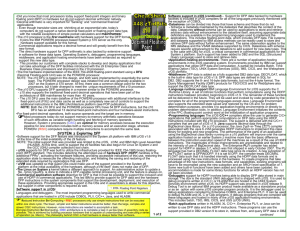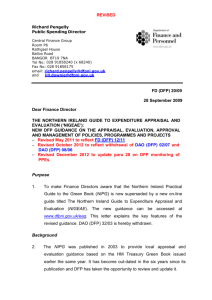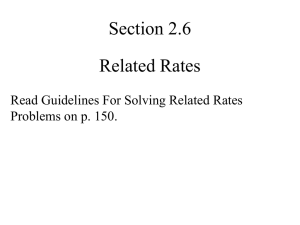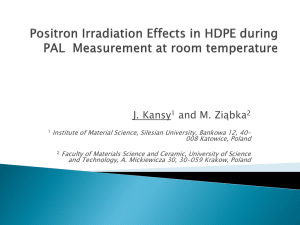Compiler Exploitation of Decimal Floating-Point Hardware
advertisement
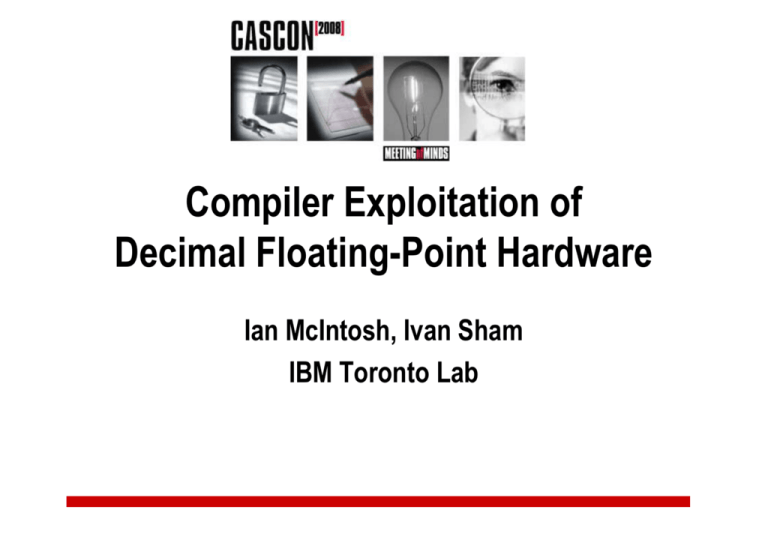
Compiler Exploitation of
Decimal Floating-Point Hardware
Ian McIntosh, Ivan Sham
IBM Toronto Lab
Why do we need Decimal Floating Point?
• Microsoft® Office Excel 2003
…Why do we need Decimal Floating Point?
public static double calculateTotal(double
price,
double
taxRate)
{
return price * (1.00 + taxRate);
}
. . .
System.out.println("Total: $" +
calculateTotal(7.0, 0.015));
----------------------------------------Output -> Total: $7.1049999999999995
Outline
• IEEE Decimal Floating Point (DFP)
• C/C++ and DFP
• Java and DFP
What is IEEE 754-2008 Decimal Floating Point?
Type Name
Size
Precision
Exponent Range
decimal32
32 bits
4 bytes
7 digits
single
-101 to +90
decimal64
64 bits
8 bytes
16 digits
double
-398 to +369
decimal128
128 bits
16 bytes
34 digits
quad
-6176 to +6111
What is Decimal Floating Point?
• Values use base 10 digits
– Alternative to Binary Floating Point
Sign
Combination
field
Exponent
continuation
Digits
continuation
Sign bit
Combination field – encodes the first two
bits of the exponent and the leftmost digit
(BCD)
Exponent continuation – encodes the remaining biased
exponent bits
Digits continuation – encodes the remaining digits in DPD 3-digit block form
-1/10
1
01000
10010000 000000000000000001
Why should we use DFP?
• Pervasive
– Decimal arithmetic is almost universal outside computers
• More accurate for decimal numbers
– Can represent “important” numbers exactly
• Programming trend
– IEEE 754, IEEE 854, IEEE 754R, IEEE 754-2008
Why should we use DFP?
• Easier to convert to/from strings
– Great for working with databases
• Performance
– More on this later
Why avoid using DFP?
•
•
•
•
•
•
It’s new and different
Not all languages include DFP
Limited support by other vendors
Software implementations can be slow
Incompatible formats (DPD and BID)
Current IBM hardware is in most cases
slower than binary floating point (BFP)
DFP at IBM
• Hardware
– POWER6 and Z10
• Microcode in Z9
– One DFP functional unit
• Non-pipelined
• Software
– XL C, XL C++, gcc, PL/I
– IBM® Developer Kit for Java™ 6
C Example – Without DFP
double calculateTotal(double price,
double taxRate)
{
return price * (1.00 + taxRate);
}
. . .
printf ("Total: $%19.16f\n",
calculateTotal(7.0, 0.015));
------------------------------------------Output -> Total: $7.1049999999999995
C Example – With DFP
_Decimal64 calculateTotal(_Decimal64 price,
_Decimal64 taxRate)
{
return price * (1.00dd + taxRate);
}
. . .
printf ("Total: $%19.16Df\n",
calculateTotal(7.0dd, 0.015dd));
------------------------------------------Output -> Total: $7.1050000000000000
C / C++ DFP
C printf / scanf Library
Format Modifier Function
Suffix
C / C++ Type Name
C++ Class Name
Literal
Suffix
_Decimal32
decimal32
df
HD
d32
_Decimal64
decimal64
dd
D
d64
_Decimal128
decimal128
dl
DD
d128
C / C++ DFP – Approaches
C syntax
DFPAL library
decNumber library
decFloat library
decNumber++ library
Easiest and most natural.
On AIX can be compiled to either
use POWER 6 DFP instructions or
call decNumber library. On z/OS
uses DFP instructions.
Automatically adapts to either using
DFP instructions or calling
decNumber.
Very portable library.
Newer and often faster library.
C++ DFP class library.
C/C++ DFP Performance – Product and Sum
In a loop:
a[i] += b[i] * c[i];
noopt
C syntax
using
decNumber
library
C syntax
using DFP
instructions
-O2
-O3
1.26x faster
2x faster
than noopt
than noopt
1.82x faster
4.37x faster
27x faster
than noopt
than noopt
than software
39x faster
59x faster
than software
than software
(Baseline)
Measured by Tommy Wong, Toronto Lab
xlc for AIX version 9 on POWER 6
C/C++ DFP Performance – C telco Benchmark
DFPAL* calls using decNumber
(Baseline)
decNumber calls
1.92x faster
DFPAL* calls using DFP instructions
2.56x faster
C syntax using DFP instructions
4.4x faster
* *DFPAL automatically adapts to either using
DFP instructions or calling decNumber.
Measured by Tommy Tse, Beaverton
xlc for AIX version 9 on POWER 6 using -O2
Decimal Floating Point in Java
• IBM Developer Kit for Java 6
• 64 bit DFP via BigDecimal class library
• POWER 6 server or Z10 mainframe
BigDecimal Class Library
• arbitrary-precision signed decimal numbers
– an arbitrary precision integer unscaled value
– 32-bit integer scale
• Supports all basic arithmetic operations
• Complete control over precision and rounding
behavior
Unscaled value: 9218302123431
92183021.23431
Scale: 5
BigDecimal and DFP
• BigDecimal can represent arbitrary significance
but 64-bit DFP restricted to
16 digits
• BigDecimal represents 32-bit exponent,
64-bit DFP restricted to 10 bits
Set of all
BigDecimal
objects
Values that cannot be
represented as DFP
DFP values that can
be represented values
BigDecimal Representation Problem
• Want to:
– Use DFP representation
– Avoid software re-try
BigDecimal a = new BigDecimal("9876543210123456",
MathContext.DECIMAL64);
BigDecimal b = new BigDecimal("1234567890987654",
MathContext.DECIMAL64);
BigDecimal c = a.add(b);
Fits in 64 64
bit DFP
Precision overflow
Hysteresis Mechanism
• Choose best representation automatically
– Base on history of operations
• Use counter and threshold
– Bias towards DFP representation
• Division, string construction, unaligned addition
– Bias towards software representation
• Compare, integer constructions
• BigDecimal constructors check counter
JIT Compiler Optimization
• Detects DFP hardware support
– Replaces checks in java code with constant
– Disables hysteresis mechanism when no DFP
• Inject DFP instructions
–
–
–
–
–
–
Load operands from BigDecimal Objects
Set rounding mode (if necessary)
Perform DFP operation
Reset rounding mode (if necessary)
Check result validity
Store result into BigDecimal Object
Example – Java / BigDecimal
public static BigDecimal calculateTotal(
BigDecimal price, BigDecimal taxRate)
{
return price.multiply(taxRate.add(BigDecimal.ONE));
}
. . .
System.out.println("Total: $" + calculateTotal(
new BigDecimal(“7.00”), new BigDecimal(“0.015”));
------------------------------------------Output -> Total: $7.1050
Microbenchmark results
HW DFP Speed up
Unaligned Addition
5.05x
Aligned Multiplication
3.03x
Aligned Division
2.23x
Half Even Rounding
1.45x
String based construction
2.08x
zLinux on Z10 using Java 6 SR2
Performance Improvement - Telco
2.25
2
1.75
Speed Up
1.5
1.25
1
0.75
0.5
0.25
0
Original / No DFP Original / Force DFP
Orignal / Default
Ideal / Default
z/OS on Z10 using Java6 SR1
Summary
• Use DFP
– Control over precision and rounding behaviour
– Accuracy for decimal numbers
– Programming trend
• High performance for suitable workloads
– DFP hardware can greatly improve performance
– 4x (2x) speedup was measured on C (Java) for Telco
Thank you!
IBM Toronto Software Lab
Ian McIntosh ianm@ca.ibm.com
Ivan Sham ivansham@ca.ibm.com
Resources
• General Decimal Arithematic
– http://www2.hursley.ibm.com/decimal/
• Decimal floating-point in Java 6: Best practices
– https://www.304.ibm.com/jct09002c/partnerworld/wps/serv
let/ContentHandler/whitepaper/power/java6_sdk/best_pra
ctice
Java command line options
• -Xdfpbd
– Disables the hysteresis mechanism
• -Xnodfpbd
– Disable DFP support and hysteresis mechanism
Hysteresis Mechanism Performance
• Multi-threaded transaction base benchmark
– Workload does not use MathContext64
1
Normalized Score
0.95
0.9
0.85
0.8
0.75
Disabled DFP
Forced DFP
Enabled Hysteresis
zLinux on Z10 using Java 6 SR2
Java Telco Performance on POWER6
1.2
1.15
Speed Up
1.1
1.05
1
0.95
0.9
No DFP
Force DFP
Default
AIX on POWER6 using Java 6
